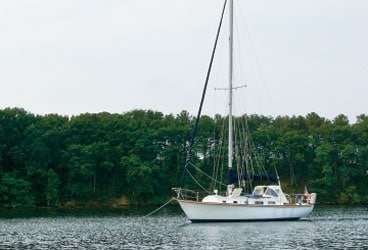
After a discouraging day of boat shopping, I was now looking for a drink. But then my wife, Terry, said, “There’s one” and pointed not at a bar but at yet another yacht brokerage. Although the boat behind the office was bigger than what we thought we wanted for daysailing and occasional overnights, Terry beckoned me aboard anyway. So began our love affair with a Bristol 34 that we named Peregrine.
Bristol Yachts produced sailboats from the drawing boards of several well-known designers. Halsey Herreshoff designed the Bristol 34, and between 1971 and 1978, Bristol built 70 of them.
Unfortunately, our boat had received little care for 10 years and could only be described as a project. We did our homework and, with a surveyor, made as complete an inventory as we could of its problems. The tally included most of the failings common to 25-year-old fiberglass boats: soggy deck, questionable rigging, blown-out sails, corroded electrical wiring, inoperative pumps, crazed gelcoat, peeling brightwork, and an overheating engine. On the positive side, the hull had no blisters. We also took the opportunity to sail on a sister ship, and that sold us.
The Bristol 34 has moderate overhangs, flare at the bow, ballast encapsulated in a modified fin keel, and a large skeg supporting the rudder. Like other Bristols, the 34 is of above-average quality with a solid fiberglass hull, balsa-cored decks, and a distinctive stainless-steel stemhead fitting that incorporates the anchor roller, bow chocks, and headstay chainplate. The single-spreader mast is stepped on the keel.
The cockpit seats six comfortably, but the steering pedestal, the wheel, and the traveler do cut off the rear third. The foredeck and side decks are uncluttered.
Below, the layout is conventional. To port of the companionway are a large chart table and a quarter berth. The small galley is opposite to starboard. Peregrine has port and starboard settees in the saloon with lockers above and behind both. (A dinette version was also available.) The port settee pulls out into a narrow double, and there’s provision for a pipe berth over the starboard settee. The dining table folds down from the main bulkhead. Forward, the athwartships head includes a toilet, a basin, a handheld shower, and a hanging locker. In the forward cabin, an insert converts the two berths to a queen-sized V-berth. Ventilation is through two large hatches, two dorade vents, and an opening port in the head.
Removing the companionway steps gives access to the front of the engine, and a panel in the quarter berth exposes its port side as well as the transmission and the stuffing box.
Peregrine handles easily. Somewhat tender initially, she settles down at 15 to 20 degrees of heel with little pressure on the helm. With good sails, she’s surprisingly quick in breezes above 5 knots. Although designed as a moderate-displacement racer/cruiser, the Bristol 34 is very seaworthy when properly equipped. At least one has sailed to Europe, and under previous owners, Peregrine sailed to Bermuda and the Caribbean. We want to take her back someday.
With reasonable care, Bristols age well. As usual, the level of maintenance received is reflected in asking prices, which range from $10,000 to $25,000.
Jim and Terry Fulton bought their Bristol 34, Peregrine, in 1999 and embarked on what became a two-year refit. They sail out of Solomons, Maryland.
Specs
LOA 34′ 3″ (10.44 m.)
LWL 26′ 0″ (7.92 m.)
Beam 10′ 5″ (3.18 m.)
Draft 5′ 6″ (1.68 m.)
Sail Area (100%) 529 sq. ft. (49.14 sq. m.)
Ballast 5,100 lb. (2,313 kg.)
Displacement 11,500 lb. (5,215 kg.)
Ballast/D .44
D/L 292
SA/D 16.6
Water 40 gal. (151 l.)
Fuel 25 gal. (95 l.)
Engine Atomic 4 (optional diesel)
Designer Halsey C. Herreshoff








